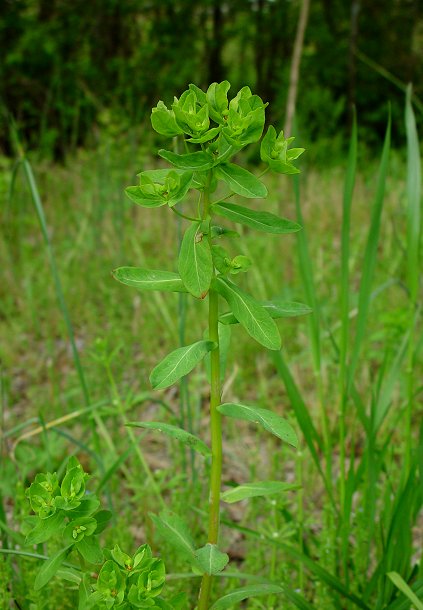Euphorbia obtusata Pursh
Blunt-Leaved Spurge

Native
CC = 3
CW = 3
MOC = 23
© DETenaglia
Euphorbia obtusata PurshBlunt-Leaved Spurge | |
 |
Native CC = 3 CW = 3 MOC = 23 |
© DETenaglia |
|
Family - Euphorbiaceae Habit - Taprooted annual forb. Sap milky.
Stems - Ascending to erect, to 70 cm, unbranched below the inflorescence or occasionally few-branched, the branches not flattened toward the tip, usually green to yellowish green, sometimes faintly purplish-tinged, glabrous.
Leaves - Alternate above the lowest node and below the inflorescence branches (those of the inflorescence branches usually opposite, those of the basal node opposite or whorled but absent at flowering), sessile. Leaf blades 10-45 mm long, oblanceolate to oblong-oblanceolate (those of the leaves of the inflorescence branches broadly ovate to broadly ovate-triangular), unlobed, rounded to truncate or shallowly cordate at the base and often somewhat clasping the stem, rounded or broadly angled to a bluntly pointed tip, the margins finely toothed mostly above the midpoint (the teeth sometimes minute and visible only with magnification), the surfaces glabrous, yellowish green to green.
Inflorescence - Terminal umbellate panicles with a whorl of leaves at the base and each of the usually 3 primary branches often branched 1-3 additional times, the cyathia solitary at the branch tips and at the branch points.
Flowers - Involucre 1.2-1.5 mm long, glabrous, the rim shallowly 4-or 5-lobed to nearly entire, the marginal glands 4 or 5, 0.3-0.6 mm long, oblong-oval to elliptic or slightly kidney-shaped, usually red or reddish-tinged (occasionally greenish yellow), lacking a petaloid appendage. Staminate flowers 5-10 per cyathium. Ovaries glabrous, but the surface densely warty, the styles 0.7-1.2 mm long, each divided 1/3-1/2 of the way from the tip into 2 slightly club-shaped lobes.
Fruits - 3.0-3.5 mm long, glabrous but the surface finely warty. Seeds 1.7-2.3 mm long, broadly elliptic-ovate to nearly circular in outline, slightly biconvex in cross-section, rounded at the base, the surface smooth, reddish brown to dark purplish brown but often appearing slightly glaucous, with a pale, irregularly winglike caruncle, this often breaking off as the seeds are dispersed.
Flowering - May - July. Habitat - Bottomland forests, streambanks, fallow fields, sandy ground, railroads, roadsides, and open, disturbed areas. Origin - Native to the U.S. Lookalikes - E. spathulata, E. commutata, E. virgata (often confused with E. esula). Other info. - This species is not particularly common, though it may be underreported. The majority of Missouri collections are from the east-central portion of the state. It ranges throughout much of the continental U.S. in scattered fashion. The plant is generally recognized by its leaf shape (widest above the middle of the blade, with fine teeth along the margins), bractlike leaves of a different shape subtending the inflorescence, and small warty fruits. However, differentiation from closely related species, especially E. spathulata, can be difficult. Some botanists consider E. obtusata a variant of E. spathulata. Photographs taken near Tom's Creek, NC., 4-20-03 (DETenaglia); also at Young Conservation Area, Jefferson County, MO, 5-17-2019, and near Labadie, Franklin County, MO, 5-12-2023 (SRTurner). |